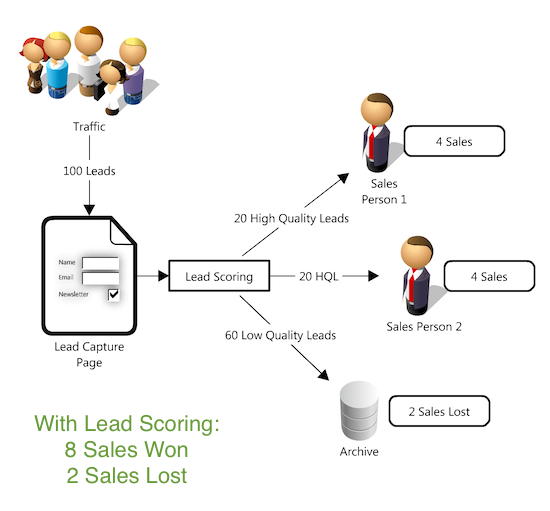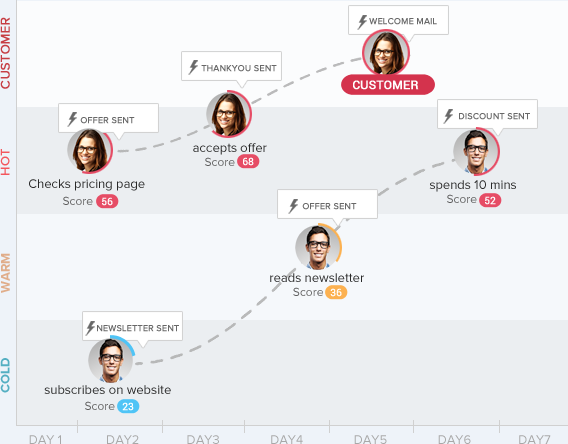What is Lead Scoring? When is it Required? And How to Score Leads?

Lead scoring is an important part of digital marketing. It used to be more of a sales function but with evolving technology and integration of marketing and sales, even digital marketers should learn about lead scoring.

What is Lead Scoring?
If you get 100 leads for your business who are likely to buy from you, it is obvious that not all of those leads are going to buy from you. There will be some leads that are more likely to buy than the others.
If you can score the leads based on the probability of whether they will buy from you or not, that’s lead scoring.
There are no standards for the numbers we assign to lead scores, but it is recommended to have a score between 0 to 100. For example, if a lead has higher score, it makes sense to focus your energy on following up with that lead, because they are more likely to buy.
When is Lead Scoring Required?
Lead scoring is not required if your entire sales process is automated. Since marketing automation systems like autoresponders will follow up with every possible lead, it doesn’t matter if the lead score is high or low.
Lead scoring is required when you are manually following up with the leads to close them. Whether you do the sales yourself or you have a sales team within your organization – human sales time is limited and it comes at a price.
Let’s say a business gets 100 leads a day. But there are only 2 sales people inside the company and the maximum number of leads that each sales person can follow up with on a given day is 20.
If there are no lead scores involved, the 2 sales people will together follow up with, let’s say 40 leads per day and let’s say they convert 10% of it – that means 4 sales a day (4/40).
Now there are another 60 leads that have not been followed up with and there are 6 more potential sales (10% of 60 leads) waiting to happen.

Now normally, without lead scoring what would a company do? Assign 3 more sales people to the sales team (but that increases the cost of business operations!).
If the business cannot afford to have more people on the sales team, they will put more pressure on the existing sales team (that may reduce their productivity and hence they may convert less of leads into customers).
So the best option here is to do lead scoring and make sure that the 2 sales people follow up with the top 40 leads that are more likely to convert and ignore the other 60 leads that are less likely to convert.
If the lead scoring is done properly, the lead to sale conversion of the sales team can double or triple. If they were converting 4 leads out of 40 before (10%) now they can convert 8 leads out of 40 leads (20%).

So from the above example, it is clear that lead scoring can help increase the performance of the existing sales team. This leads to more profits and the capability to generate even more leads – because you can reinvest the profits back into marketing.
How to do Lead Scoring?
There are two major methods of lead scoring.
- Based on information
- Based on behaviour
Lead Scoring Based on Information
During the lead generation process, if the person gives away more information than contact details, that information can be used to assign a score to that lead.
For example, ‘Designation’ is a great indicator. If there is a business SaaS product and if a student signs up for it, then the sales team can ignore that lead. A student is probably checking out what the tool is about and is very unlikely to buy.
However, if a CEO of a company is signing up, then the sales team can know that this specific lead is highly likely to buy.
If you have tried signing up for free trials of products online, you would have noticed that they ask you questions like your designation, the size of your company, the industry category of your company and so on. All such information is used to score the leads.
Lead Scoring Based on Behaviour
Another way to score the leads is based on the behaviour of the leads. Tracking their behaviour is not easy and it also crosses some ethical lines. But as long as you have a clear fine print and the technology to implement such tracking, you are good to go!
A lead who has signed up on your website immediately after visiting one page is not as valuable as a lead who has spent more than 5 minutes on 4 different pages and then signed up. The second lead is a more serious lead and is better informed and educated about your product than the first lead.
Tools for Leads Scoring
There are many tools in the market that will help you do lead scoring. Many companies build their own lead scoring mechanism and formula – and such approach is usually the best.
LeadSquared.com is a good tool for lead scoring that I came across recently. Read a review of LeadSquared here. Here’s an image from their page that clearly explains the concept of lead scoring based on behaviour.

Observe that they are adding a few points for each behaviour that is moving the prospect towards the direction of becoming a customer.
If a new lead signs up on the website and then doesn’t do anything else, then he/she is not likely to buy. The score will not go up in this case. The sales team will be able to filter the leads based on their scores and then work on it.
Lead scoring need not stop once the customer buys the product. In many companies, the first product is just the tripwire (a low-priced front end product to make a prospect into a paying customer). Profits are usually made only during subsequent sales.
Having scores even after the first purchase would help the sales team focus properly on the leads (or customers) who are more likely to buy the higher end products.